The Effect of Rootstock Activity for Growth and Root System Soaking in Trichoderma atroviride on the Graft Success and Continued Growth of Beech (Fagus sylvatica L.) Plants
Abstract
1. Introduction
2. Material and Methods
2.1. Plant Material and Growth Conditions
2.2. Morphological Plants Growth and Gas Exchange Measurements
2.3. Data Analysis
3. Results
4. Discussion
4.1. Results of First Experiment
4.2. Results of Second Experiment
5. Conclusions
Funding
Institutional Review Board Statement
Informed Consent Statement
Data Availability Statement
Conflicts of Interest
References
- Hatch, L. Cultivars of Woody Plants; TCR Press: Raleigh, NC, USA, 2007; Digital Book; Volume I (A-G), pp. 906–927. [Google Scholar]
- Carey, M.D.; Mason, M.E.; Bloese, P.; Koch, J.L. Hot callusing of propagation of American beech by grafting. HortScience 2013, 48, 620–624. [Google Scholar] [CrossRef]
- Howe, C.F. The Production of Container–Grown Trees by Bench Grafting–Some Criteria for Success. Inter. Plant Propag. Soc. Com. Proc. 1976, 26, 145–149. [Google Scholar]
- Donald, B.M. Practical Woody Plant Propagation for Nursery Growers; Timber Press: Kreton/Portland, OR, USA, 1996; Volume 1, p. 669. [Google Scholar]
- Hartmann, H.T.; Kester, D.E. Simon and Schuster/A Viacom Company Upper Saddle River. In Plant Propagation Principles and Practices; Prentice-Hall Inc.: Hoboken, NJ, USA, 1997; p. 770. [Google Scholar]
- Krüssmann, G. Die Baumschule; Parey, V.P., Ed.; 6 Auflage: Berlin/Hamburg, Germny, 1997; p. 982. [Google Scholar]
- Jayawickrama, K.J.S.; McKeand, S.E.; Jett, J.B. Rootstock effects on scion growth and reproduction i 8-year-old grafted loblolly pine. Can. J. For. Res. 1997, 27, 1781–1787. [Google Scholar] [CrossRef]
- Frey, H.H.; Frampton, J.; Blazich, F.A.; Hinesley, L.E. Grafting Fraser Fir (Abies fraseri): Effect of grafting date, shade and irrigation. HortScience 2010, 45, 617–620. [Google Scholar] [CrossRef]
- Almqvist, C. Interstock effects on topgraft vitality and strobili production after topgrafting in Pinus sylvestris. Can. J. For. Res. 2013, 43, 584–588. [Google Scholar] [CrossRef]
- Shu, W.B.; Liang, Y.Y.; Yang, Z.Q.; Su, W.B.; Liang, X.Z. The graft technology of high-yield Pinus massoniana seed orchard. J. Fujian For. Sci. Tech. 2013, 1, 21. [Google Scholar]
- Barnett, J.R.; Weatherhead, I. The effect of scion water potential on graft success in Sitka spruce (Picea sitchensis). Ann. Bot. 1989, 64, 9–12. [Google Scholar] [CrossRef]
- Wen-Jun, F. Effect analysis of twig grafting of Pinus taiwanensis. J. Fujian For. Sci. Tech. 2007, 4, 26. [Google Scholar]
- Ramirez, M.; Loo, J.; Krasowski, M.J. Evaluation of Resistance to the Beech Scale Insect (Cryptococcus fagisuga) and Propagation of American Beech (Fagus grandifolia) by Grafting. Silvae Genet. 2007, 56, 163–166. [Google Scholar] [CrossRef][Green Version]
- Kitamura, M.; Lemos, E. Early grafting in Annona muricata. Rev. Bras. Fructic. 2004, 26, 186–188. [Google Scholar] [CrossRef]
- Bärtels, A. Der Baumschulbetrieb; Eugen, U., Ed.; 4 Auflage: Stuttgart, Germany, 1995; p. 739. [Google Scholar]
- Hallett, R.D.; Smith, R.F.; Burns, T.W. Manual for Greenhouse Grafting of Conifers in the Maritimes. In Natural Resources Canada, Canadian Forest Service–Atlantic Forestry Centre Information Report M-X-117; Canadian Forest Service: Fredericton, NB, Canada, 1981; p. 28. [Google Scholar]
- Karadeniz, T. Relationship between graft success and climatic values in valnut (Juglans regia L.). J. Cent. Eur. Agr. 2005, 6, 631–634. [Google Scholar]
- Pina, A.; Errea, P. A review of new advances in mechanism of graft compatibility–incompatibility. Sci. Hortic. 2005, 106, 1–11. [Google Scholar] [CrossRef]
- Obdrzalek, J.; Jilkova, J. Winter grafting of oaks Quercus L. Hortic. Sci. 2006, 33, 61–69. [Google Scholar] [CrossRef]
- Dirr, M.A.; Heuser, C.W. The Reference Manual of Woody Plant Propagation. From Seed to Tissue Culture; Varsity Press: Athens, GA, USA, 1987; p. 239. [Google Scholar]
- Woo, S.L.; Ruocco, M.; Vinale, F.; Nigro, M.; Marra, R.; Lombardi, N.; Lorito, M. Trichoderma-based products and their widespread use in agriculture. Open Mycol. J. 2014, 8, 71–126. [Google Scholar] [CrossRef]
- Vinale, F.; Sivasithamparam, K.; Ghisalberti, E.L.; Marra, R.; Barbetti, M.J.; Li, H.; Woo, S.L.; Lorito, M. A novel role for Trichoderma secondary metabolites in the interactions with plants. Physiol. Mol. Plant Pathol. 2008, 72, 80–86. [Google Scholar] [CrossRef]
- Anam, G.B.; Reddy, M.S.; Ahn, Y.H. Characterization of Trichoderma asperellum RM-28 for its sodic/saline-alkali tolerance and plant growth promoting activities to alleviate toxicity of red mud. Sci. Total Environ. 2019, 662, 462–469. [Google Scholar] [CrossRef]
- Benìtez, T.; Rincòn, A.M.; Limòn, M.C.; Codòn, A.C. Biocontrol mechanisms of Trichoderma strains. Int. Microbiol. 2004, 7, 249–260. [Google Scholar]
- Chowdappa, P.; Kumar, S.P.M.; Lakshmi, M.J.; Upreti, K.K. Growth stimulation and induction of systemic resistance in tomato against early and late blight by Bacillus subtilis OTPB1 or Trichoderma harzianum OTPB3. Biol. Control 2013, 65, 109–117. [Google Scholar] [CrossRef]
- Martínez-Medina, A.; Alguacil, M.D.M.; Pascual, J.A.; Van Wees, S.C.M. Phytohormone profiles induced by Tichoderma isolates correspond with their biocontrol and plant growth-promoting activity on melon plants. J. Chem. Ecol. 2014, 40, 804–815. [Google Scholar] [CrossRef]
- Vinodkumar, S.; Indumathi, T.; Nakkeeran, S. Trichoderma asperellum (NVTA2) as a potential antagonist for the management of stem rot in carnation under protected cultivation. Biol. Control 2017, 113, 58–64. [Google Scholar] [CrossRef]
- Di Vaio, C.; Testa, A.; Cirillo, A.; Conti, S. Slow-release fertilization and Trichoderma harzianum-based biostimulant for the nursery production of young olive trees (Olea europaea L.). Agron. Res. 2021, 19, 1396–1405. [Google Scholar] [CrossRef]
- Chet, I.; Inbar, J.; Hadar, I. Fungal antagonists and mycoparasites. In The Mycota IV. Environmental and Microbial Relationships; Wicklow, D.T., Söderström, B., Eds.; Springer: Berlin, Germany, 1997; pp. 165–184. [Google Scholar]
- Tandon, A.; Fatima, T.; Gautam, A.; Yadav, U.; Srivastava, S.; Singh, P.C. Effect of Trichoderma koningiopsis on chickpea rhizosphere activities under different fertilization regimes. Open J. Soil Sci. 2018, 8, 261. [Google Scholar] [CrossRef]
- Zhao, L.; Wang, F.; Zhang, Y.; Zhang, J. Involvement of Trichoderma asperellum strain T6 in regulating iron acquisition in plants. J. Basic Micr. 2014, 54, 115–124. [Google Scholar] [CrossRef]
- Li, Y.T.; Hwang, S.G.; Huang, Y.M.; Huang, C.H. Effects of Trichoderma asperellum on nutrient uptake and Fusarium wilt of tomato. Crop Prot. 2018, 110, 275–282. [Google Scholar] [CrossRef]
- Yedidia, I.; Srivastva, A.K.; Kapulnik, Y.; Chet, I. Effect of Trichoderma harzianum on microelement concentrations and increased growth of cucumber plants. Plant Soil 2001, 235, 235–242. [Google Scholar] [CrossRef]
- Longstreth, D.J.; Nobel, P.S. Nutrient Influences on Leaf Photosynthesis: Effects of nitrogen, phosphorus, and potassium for Gossypium hirsutum L. Plant Physiol. 1980, 65, 541–543. [Google Scholar] [CrossRef]
- Anjum, S.A.; Wang, L.; Farooq, M.; Xue, L.; Ali, S. Fulvic acid application improves the maize performance under well-watered and drought conditions. J. Agron. Crop Sci. 2011, 197, 409–417. [Google Scholar] [CrossRef]
- Díaz-Leguizamón, J.J.; Chingaté-Cruz, O.F.; Sánchez-Reinoso, A.D.; Restrepo-Díaz, H. The effect of foliar applications of a bio-stimulant derived from algae extract on the physiological behavior of lulo seedlings (Solanum quitoense cv. Septentrionale). Cienc. Investig. Agrar. 2016, 43, 25–37. [Google Scholar] [CrossRef][Green Version]
- Shoresh, M.; Harman, G.E.; Mastouri, F. Induced systemic resistance and plant responses to fungal biocontrol agents. Annu. Rev. Phytopathol. 2010, 48, 21–43. [Google Scholar] [CrossRef]
- Schmidtling, R.C. Rootstock influences flowering, growth and survival of loblolly pine grafts. Forest Sci. 1983, 29, 117–124. [Google Scholar]
- Haines, R.J.; Simpson, J.A. Scion-rootstock relationships with respect to height growth and foliar concentrations of nitrogen and phosphorus in reciprocal grafts of Pinus caribaea var. hondurensis. New For. 1994, 8, 71–79. [Google Scholar]
- Jayawickrama, K.J.S.; Jett, J.B.; McKeand, S.E. Rootstock effects in grafted conifers: A review. New For. 1991, 5, 157–173. [Google Scholar] [CrossRef]
- Nonić, M.Ž.; Skočajić, D.M.; Grbić, M.N.; Šijačić-Nikolić, M.T. Variability of Quantitative and Qualitative Characteristics of Fagus sylvatica ‘Purpurea’ Clones Produced by Grafting. Not. Bot. Horti Agro. Cluj-Napoca 2017, 45, 400–407. [Google Scholar] [CrossRef]
- Nonić, M.Ž.; Šijačić-Nikolić, M.T.; Kneżević, R. Analysis of survival and vitality of beech plants grafted by method of splice grafting. In Proceedings of the International Scientific Conference ‘Forests in the Future-Sustainable Use, Risks and Challenges’, Belgrade, Serbia, 4–5 October 2012; pp. 425–432. [Google Scholar]
- Savill, P.S.; Fennessy, J.; Samuel, C.J.A. Approaches in Great Britain and Ireland to the genetic improvement of broadleaved trees. Forestry 2005, 78, 163–173. [Google Scholar] [CrossRef]
- Saturam, F.B.S.; Nurmalasari, I.R. The Effect of Trichoderma and Onion Extract on the Success of Grafting in Mango Seedlings. In Proceedings of the 2nd International Conference Earth Science and Energy, Kuala Lumpur, Malaysia, 11 November 2020; p. 819. [Google Scholar] [CrossRef]
- Rosmana, A.; Nasaruddin, N.; Hendarto, H.; Hakkar, A.A.; Nursalim Agriansyah, N. Endophytic Association of Trichoderma asperellum within Theobroma cacao Suppresses Vascular Streak Dieback Incidence and Promotes Side Graft Growth. Mycobiology 2016, 44, 180–186. [Google Scholar] [CrossRef]
- Hermosa, R.; Viterbo, A.; Chet, I.; Monte, E. Plant beneficial effects of Trichoderma and of its genes. Microbiology 2021, 158, 17–25. [Google Scholar]
- Etebarian, H.R.; Scott, E.S.; Wicks, T.J. Trichoderma harzianum T39 and T. virens DAR 74290 as potential biological control agents for Phytoptora erythroseptica. Eur. J. Plant Pathol. 2000, 106, 329–337. [Google Scholar] [CrossRef]
- Hỳsek, J.; Vach, M.; Brožová, J.; Sychrová, E.; Civínová, M.; Nedĕlník, J.; Hrubỳ, J. The influence of the application of mineral fertilizers with the biopreparation Supresivit (Trichoderma harzianum) on the health and the yield of different crops. Arch. Phytopathol. Plant Prot. 2002, 35, 115–124. [Google Scholar] [CrossRef]
- Harman, G.E.; Howell, C.R.; Viterbo, A.; Chet, I.; Lorito, M. Trichoderma species-opportunistic, avirulent plant symbionts. Nat. Rev. 2004, 2, 43–56. [Google Scholar] [CrossRef]
- López-Bucioa, J.; Pelagio-Floresa, R.; Herrera-Estrella, A. Trichoderma as biostimulant: Exploiting the multilevel properties of a plant beneficial fungus. Sci. Hortic. 2015, 196, 109–123. [Google Scholar] [CrossRef]
- Zeilinger, S.; Gruber, S.; Bansal, R.; Mukherjee, P.K. Secondary metabolism in Trichoderma chemistry meets genomics. Fungal Biol. Rev. 2016, 30, 74–90. [Google Scholar] [CrossRef]
- Vinale, F.; Sivasithamparam, K.; Ghisalberti, E.L.; Woo, S.L.; Nigro, M.; Marra, R.; Lombardi, N.; Pascale, A.; Ruocco, M.; Lanzuise, S.; et al. Trichoderma secondary metabolites active on plants and fungal pathogens. Open Mycol. J. 2014, 8, 127–139. [Google Scholar] [CrossRef]
- Azarmi, R.; Hajieghrari, B.; Giglou, A. Effect of Trichoderma isolates on tomato seedling growth response and nutrient uptake. Afr. J. Biotech. 2011, 10, 5850–5855. [Google Scholar]
- Rakibuzzaman, M.; Akand, M.H.; Siddika, M.; Uddin, A.J. Impact of Trichoderma application as bio-stimulator on disease suppression, growth and yield of potato. J. Biosci. Agric. Res. 2021, 27, 2252–2257. [Google Scholar] [CrossRef]
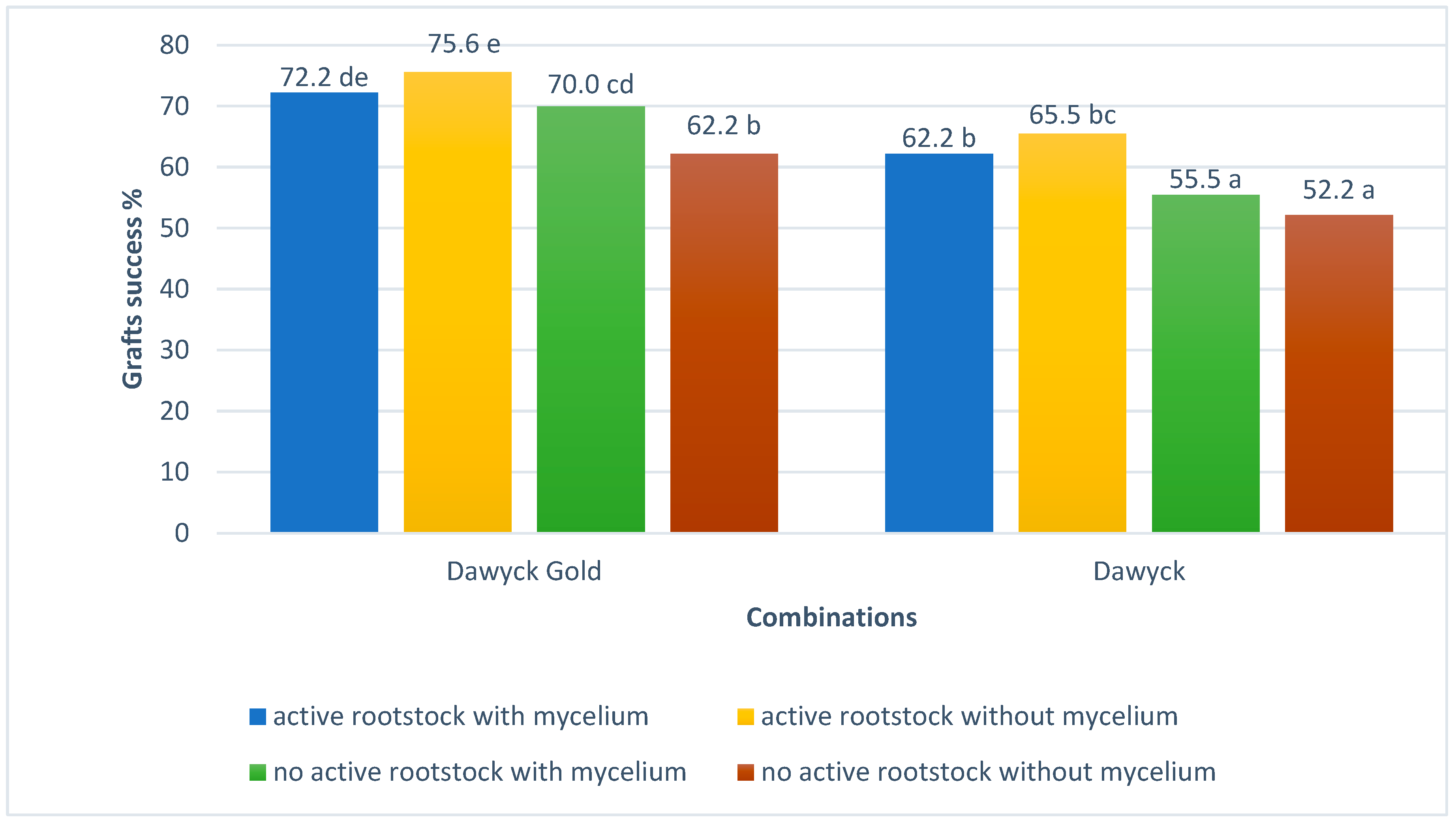
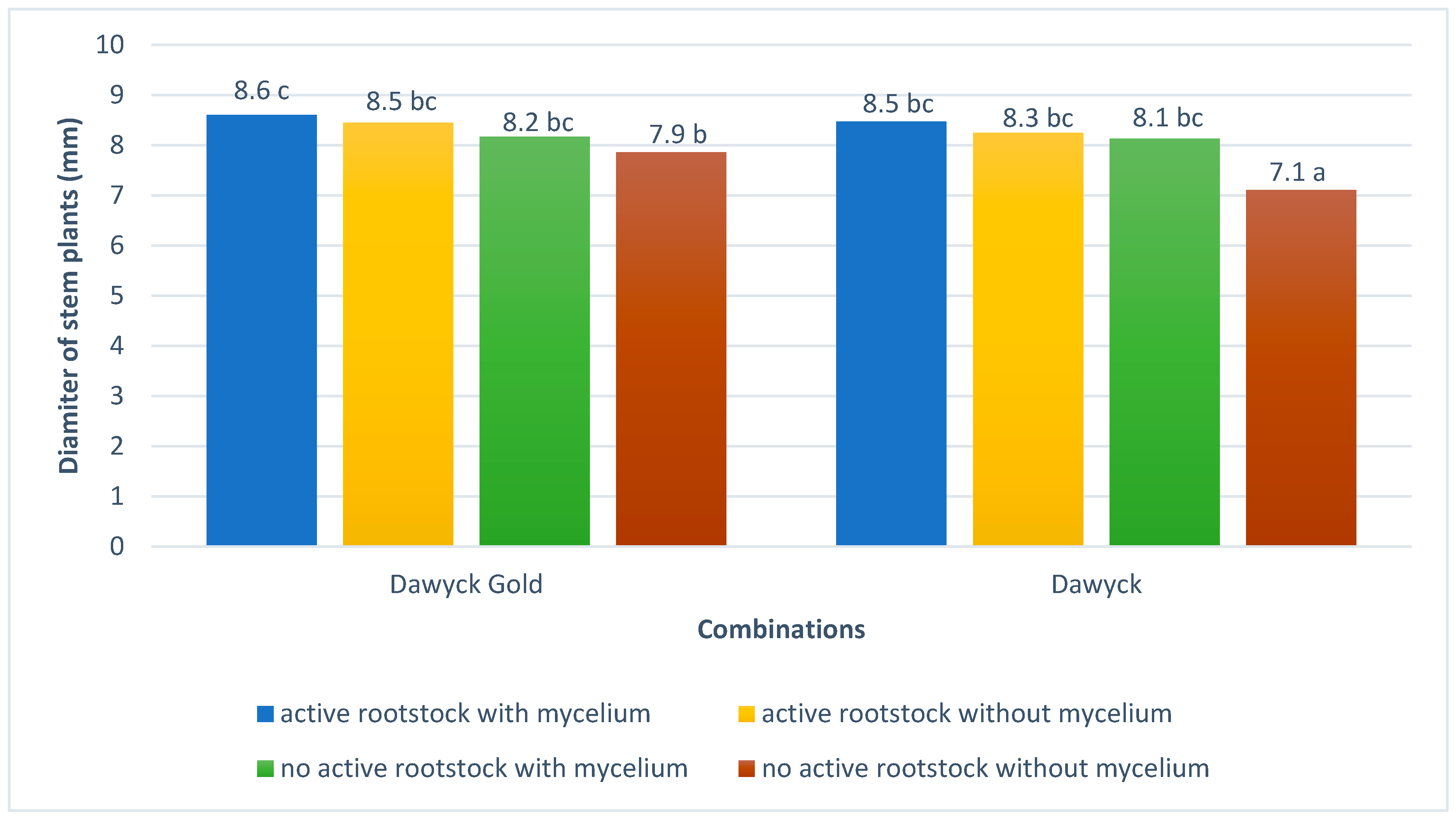
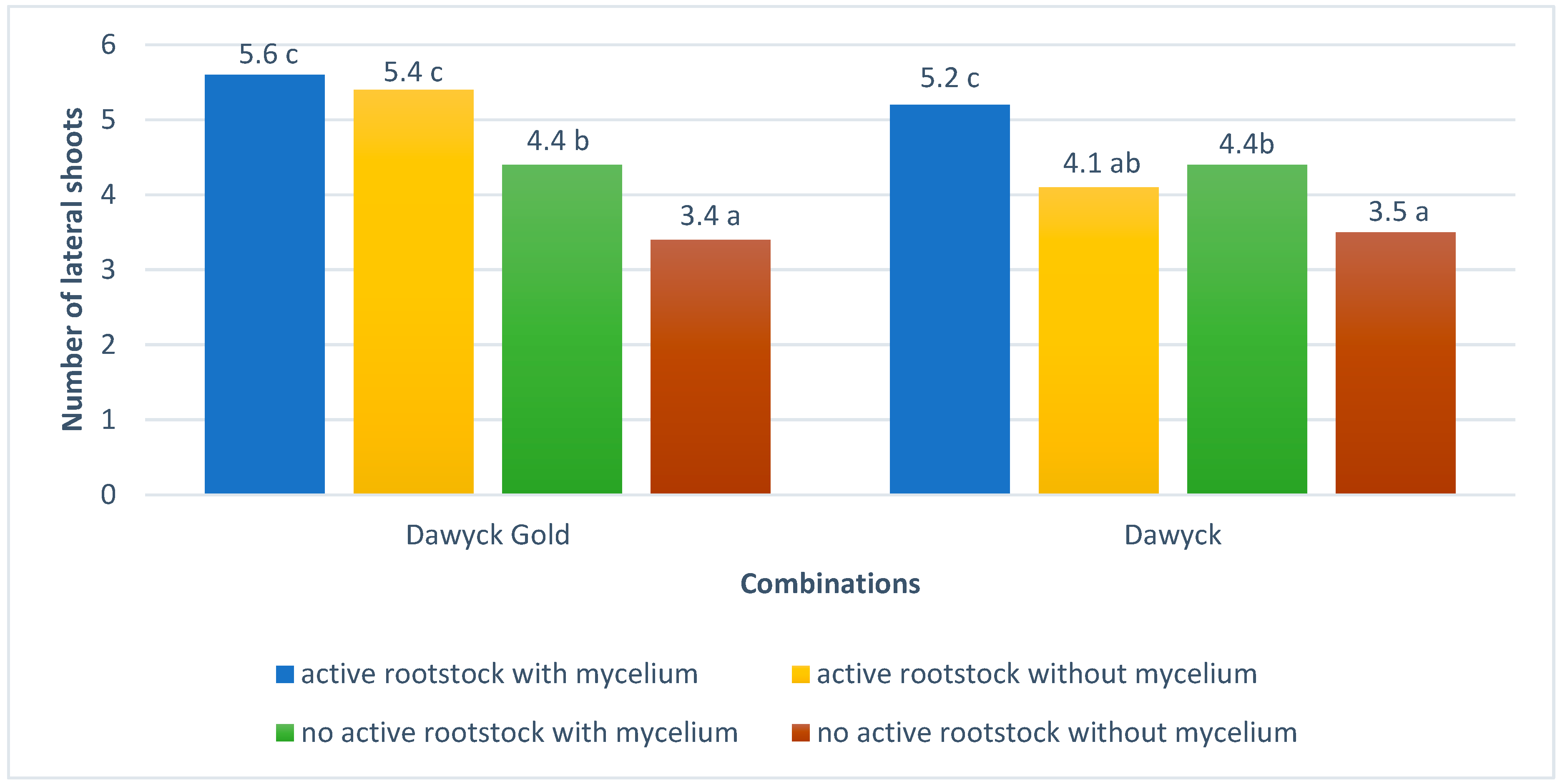
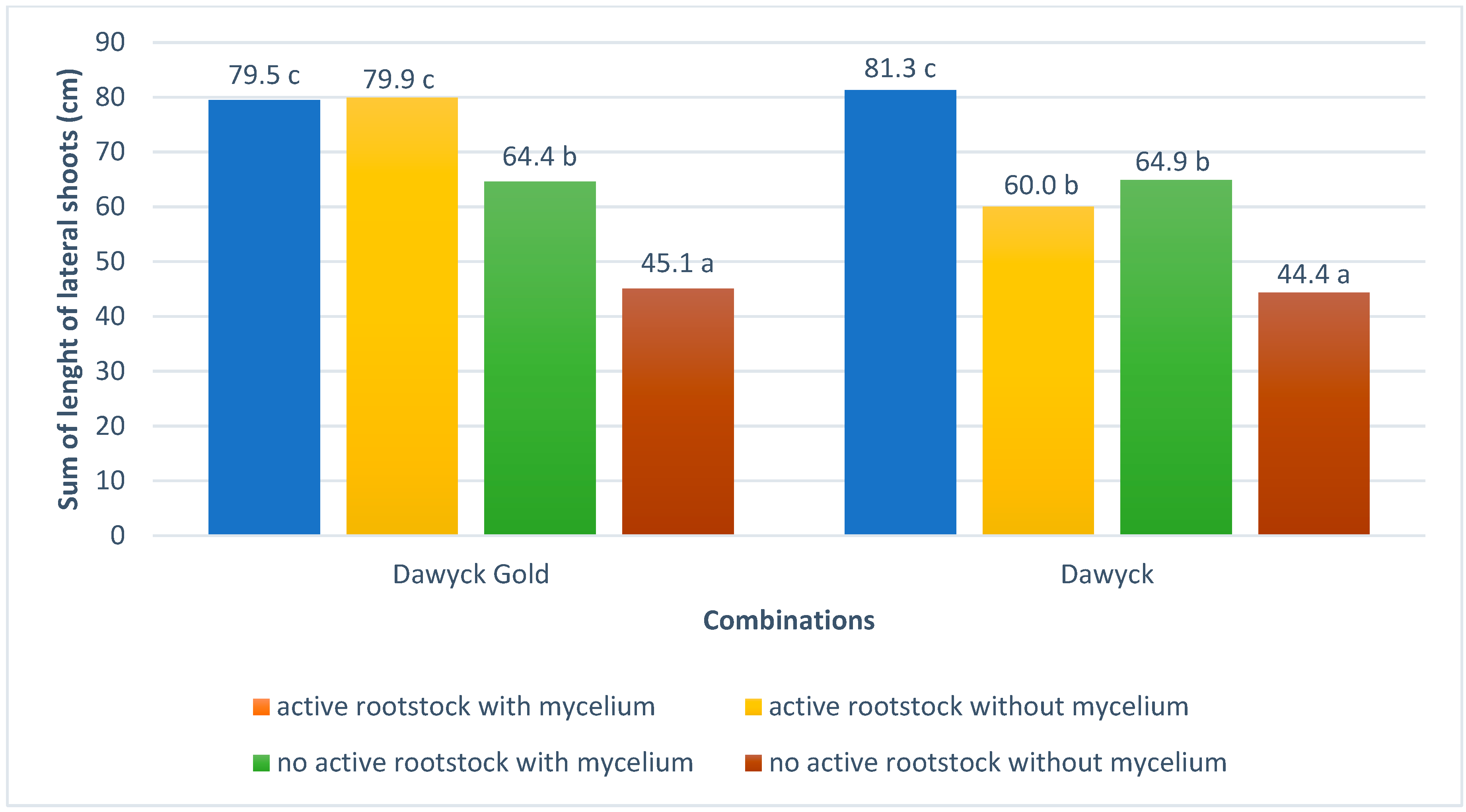
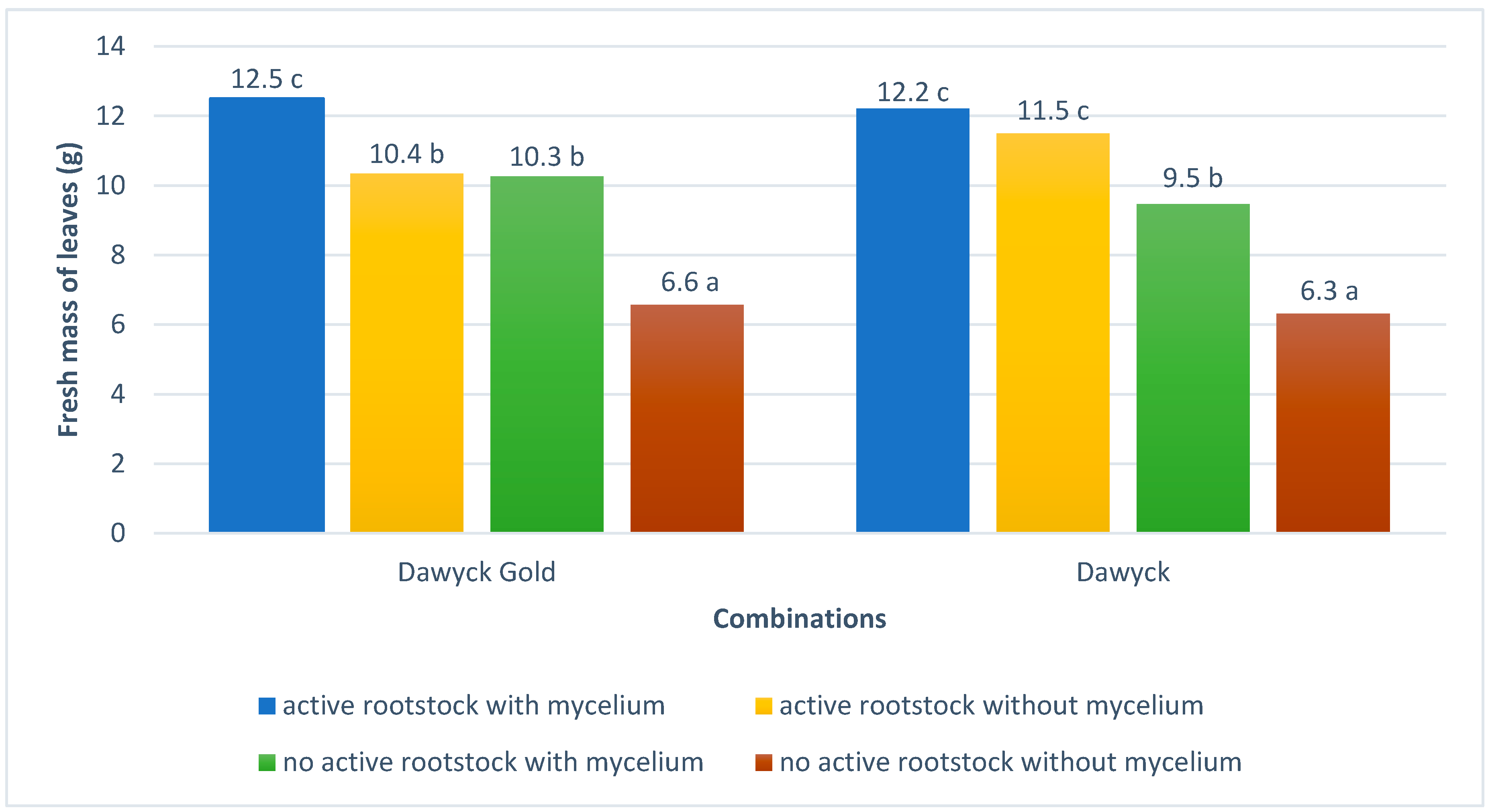




| N-NO3 | P | K | Ca | Mg | pH in H2O | Salnity NaCl g·dm−3 |
|---|---|---|---|---|---|---|
| 54 | 62 | 35 | 1923 | 139 | 6.5 | 1.3 |
| Cultivar | Rootstock with Active Growth | Rootstock without Active Growth | No Active Rootstock with Bare Root System | Average for Cultivar |
|---|---|---|---|---|
| ‘Dawyck Gold’ | 90.0 hi | 60.0 bc | 70.0 de | 73.3 b |
| ‘Dawyck Purple’ | 80.0 fg | 80.0 fg | 91.7 hi | 83.9 c |
| ‘Purpurea Pendula’ | 75.0 ef | 55.0 b | 85.0 gh | 71.7 ab |
| ‘Purpurea Tricolor’ | 85.0 gh | 65.0 cd | 95.0 i | 81.7 c |
| ‘Rohan Obelisk’ | 70.0 de | 45.0 a | 90.0 hi | 68.3 a |
| Average for rootstock | 80.0 b | 61.0 a | 86.3 c |
| Cultivar | Rootstock with Active Growth | Rootstock without Active Growth | No Active Rootstock with Bare Root System | Average Value for Cultivar |
|---|---|---|---|---|
| ‘Dawyck Gold’ | 42.4 d | 48.4 e | 25.8 a | 38.9 b |
| ‘Dawyck Purple’ | 53.7 f | 42.5 d | 28.9 a | 41.7 c |
| ‘Purpurea Pendula’ | 40.7 cd | 27.3 a | 35.4 b | 34.5 a |
| ‘Purpurea Tricolor’ | 42.4 d | 36.2 bc | 26.0 a | 34.9 a |
| ‘Rohan Obelisk’ | 43.1 d | 48.4 e | 41.8 d | 44.4 d |
| Average for rootstock | 44.5 c | 40.6 b | 31.6 a |
| Cultivar | Rootstock with Active Growth | Rootstock without Active Growth | No Active Rootstock with Bare Root System | Average Value for Cultivar |
|---|---|---|---|---|
| ‘Dawyck Gold’ | 7.3 ef | 6.9 e | 5.2 a–c | 6.5 c |
| ‘Dawyck Purple’ | 7.7 f | 6.7 de | 5.6 bc | 6.6 c |
| ‘Purpurea Pendula’ | 5.9 cd | 5.6 bc | 5.5 bc | 5.7 b |
| ‘Purpurea Tricolor’ | 5.6 bc | 4.4 a | 5.0 ab | 5.0 a |
| ‘Rohan Obelisk’ | 7.3 ef | 6.6 de | 6.0 cd | 6.6 c |
| Average for rootstock | 6.8 c | 6.0 b | 5.5 a |
| Cultivar | Rootstock with Active Growth | Rootstock without Active Growth | No Active Rootstock with Bare Root System | Average Value for Cultivar |
|---|---|---|---|---|
| ‘Dawyck Gold’ | 2.2 b | 2.2 b | 1.6 a | 2.0 a |
| ‘Dawyck Purple’ | 3.0 e | 2.5 bcd | 1.3 a | 2.3 b |
| ‘Purpurea Pendula’ | 2.4 b–d | 1.4 a | 2.1 b | 2.0 a |
| ‘Purpurea Tricolor’ | 2.3 bc | 1.7 a | 2.3 bc | 2.1 ab |
| ‘Rohan Obelisk’ | 3.1 e | 2.8 de | 2.8 cde | 2.9 c |
| Average for rootstock | 2.6 b | 2.1 a | 2.0 a |
| Cultivar | Rootstock with Active Growth | Rootstock without Active Growth | No Active Rootstock with Bare Root System | Average for Cultivar |
|---|---|---|---|---|
| ‘Dawyck Gold’ | 22.8 e | 12.2 bc | 5.2 a | 13.4 ab |
| ‘Dawyck Purple’ | 20.2 de | 22.4 e | 12.5 bc | 18.4 c |
| ‘Purpurea Pendula’ | 21.1 de | 10.4 bc | 12.0 bc | 14.5 b |
| ‘Purpurea Tricolor’ | 13.2 c | 13.3 c | 9.0 b | 11.8 a |
| ‘Rohan Obelisk’ | 18.2 d | 11.5 bc | 9.1 b | 12.9 ab |
| Average for type of rootstock | 19.1 c | 14.0 b | 9.0 a |
| Cultivar | Rootstock with Active Growth | Rootstock without Active Growth | No Active Rootstock with Bare Root System | Average for Cultivar |
|---|---|---|---|---|
| ‘Dawyck Gold’ | 7.0 fg | 6.1 def | 6.4 efg | 6.5 c |
| ‘Dawyck Purple’ | 11.0 j | 8.7 hi | 4.9 cd | 8.2 d |
| ‘Purpurea Pendula’ | 5.6 de | 4.2 bc | 4.9 cd | 4.9 b |
| ‘Purpurea Tricolor’ | 3.1 ab | 3.1 ab | 2.5 a | 2.9 a |
| ‘Rohan Obelisk’ | 11.3 j | 9.4 i | 7.5 gh | 9.4 e |
| Average for type of rootstock | 7.6 c | 6.3 b | 5.3 a |
Publisher’s Note: MDPI stays neutral with regard to jurisdictional claims in published maps and institutional affiliations. |
© 2022 by the author. Licensee MDPI, Basel, Switzerland. This article is an open access article distributed under the terms and conditions of the Creative Commons Attribution (CC BY) license (https://creativecommons.org/licenses/by/4.0/).
Share and Cite
Świerczyński, S. The Effect of Rootstock Activity for Growth and Root System Soaking in Trichoderma atroviride on the Graft Success and Continued Growth of Beech (Fagus sylvatica L.) Plants. Agronomy 2022, 12, 1259. https://doi.org/10.3390/agronomy12061259
Świerczyński S. The Effect of Rootstock Activity for Growth and Root System Soaking in Trichoderma atroviride on the Graft Success and Continued Growth of Beech (Fagus sylvatica L.) Plants. Agronomy. 2022; 12(6):1259. https://doi.org/10.3390/agronomy12061259
Chicago/Turabian StyleŚwierczyński, Sławomir. 2022. "The Effect of Rootstock Activity for Growth and Root System Soaking in Trichoderma atroviride on the Graft Success and Continued Growth of Beech (Fagus sylvatica L.) Plants" Agronomy 12, no. 6: 1259. https://doi.org/10.3390/agronomy12061259
APA StyleŚwierczyński, S. (2022). The Effect of Rootstock Activity for Growth and Root System Soaking in Trichoderma atroviride on the Graft Success and Continued Growth of Beech (Fagus sylvatica L.) Plants. Agronomy, 12(6), 1259. https://doi.org/10.3390/agronomy12061259






